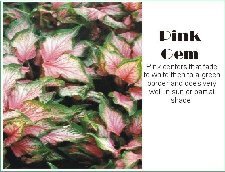Garden Edition:
August 2001
by Linda Coyner
Forget baseball. For me, the hot, humid days of August will forever be associated with caladiums. It was on those warm days I'd retreat to my New York State patio, surrounded by big pots of leaves vividly painted red, pink, green, and white in hot and cool combinations, to view my garden. But what fascinates me most about this plant is the ornate veining and patterns that make each leaf and every combination unique.
In the Northeast, the heat and humidity of August make it prime time for growing caladiums. Potted plants are usually available at local nurseries and are a quick and easy fix to fading borders and containers. (Tubers are a cheaper way to go but would need to have been started inside in June or in the ground in July; see later in the article for details).
For my subtropical garden, August means time for a second planting. The first round of tubers went into the ground in April and about now wear themselves out. Besides borders and beds, this fancy foliage plant is ideal for pots and hanging baskets on the porch or patio. But what few people know is that the cut leaf adds a long-lasting tropical splash to indoor flower arrangements. In my house cut leaves go from garden directly into arrangements without any fussing but I've read that leaves last longer if soaked overnight.
Caladiums also bloom, but the flower is insignificant, especially compared to the showy foliage. The flower, like that of a calla lily, consists of many tiny flowers on a central stalk (spadix), which is surrounded by a modified leaf called a spathe. The greenish-white flower drains the energy of the plant and should be pinched off as soon as possible. Although native to tropical South America, caladiums are very Florida friendly. In fact, south central Florida is where 1200 acres produce 97% of the world's supply of the foliage plant. Most, if not all, of the currently grown plants are hybrids of several wild species, chiefly Caladium bicolor.
All parts of this tropical plant are poisonous, so caution is advised around children and pets, although my dog and cats have never shown any interest. The sap may be irritating to some gardeners so it's a good idea to wear gloves until you know if you're sensitive.
The majority of caladiums come from an area centered in the tiny town of Lake Placid, Florida, which calls itself the Caladium Capital of the World and is home to the annual celebration. The small town and its growers gear up the festival in late August as it has for the past 11 years. This year's dates are August 24 through 26.
In addition to the usual trappings of a festival—T-shirts, arts and crafts, and lots of food—there's an exhibit of specimen and rare caladiums and plenty of opportunity to buy bulbs and plants. When you've had your fill of that, you can climb on board a bus to tour caladium fields and production areas. Buses meander through neighborhoods to which growers have supplied an unlimited amount of plants (can you imagine?) in order to demonstrate the many ways homeowners can use caladiums in the landscape. (See the happinessfarms.com web site for more information about the festival.)
This particular area, Highlands County, has become the epicenter for growing caladiums because, besides the warm climate, it boasts dried up lake bottoms left behind by the glaciers. The rich, organic muck, in some places said to be 25' deep, provides a perfect medium for caladium tubers.
The season actually starts with planting in late April or when the ground is dry enough. Growers have learned from experience that the muck can bog down heavy equipment when it's too wet. To make more plants, growers cut individual tubers into segments (chips) with eyes and plant them, much like is done with potatoes. In November and December, the tubers mature into breathtaking rivers of colorful foliage. By February, the plants die back enough to be dug.
Types
The main type of caladium is called Fancy Leaf. Its leaves are heart-shaped and large, typically 8 to 12 inches long. The plant grows about 15 inches tall, but will vary in size between varieties. When densely planted, or planted in the shade, they will grow even taller. Varieties in this group are Candidum, White Christmas, Frieda Hemple, Carolyn Whorton, and Pink Beauty.

>>>>2






